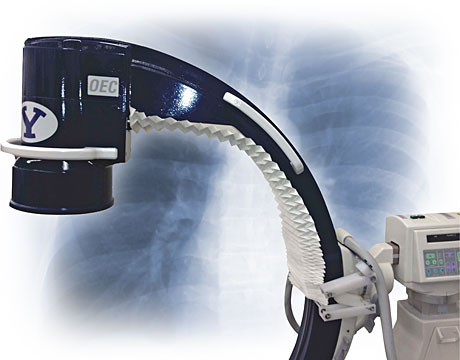Engineering Meets Art
Engineering Meets Art


A reconfigurable C-arm of an X-ray machine with the shroud that expands and contracts like origami. Image: GE Healthcare
Engineers are applying the principles of a 17th-century Japanese art form to develop innovative products and structures that are meeting a variety of challenging design situations in a host of industries.
The old art form, origami, creates unique patterns and shapes from paper folding. Today origami is inspiring engineers to design active materials and smart structures that bend, stretch, and curve, overcoming traditional design constraints to render products and systems with remarkable performance characteristics and features.
The amazingly compact automobile airbag is an example of origami-inspired engineering, which is also making commercial inroads in the energy, apparel, and healthcare industries. Reflecting the emerging interest in the field, the National Science Foundation recently provided funding to eight U.S. universities to advance origami engineering into the realm of reconfigurable smart structures and self-assembling systems.
“Origami engineering can meet the demand across multiple industries for products and systems with very complex applications,” says Mary Frecker, a professor of mechanical engineering and biomedical engineering at The Pennsylvania State University, University Park, one of the schools to receive an NSF research grant. “Origami enables products with the ability to fold and then unfold on demand – at any time.”
To create products to do that, engineers are incorporating active materials like magneto-active elastomers and polymer films into the origami-inspired structure. Then an external stimulus such as a magnetic or electric field is exerted on the material, inducing the structure to crease, fold, bend, and exhibit other characteristics.
While the material is almost magical in its ability to morph into different shapes and patterns, the challenge for engineers is create a system that is structurally sound and can be fabricated for practical use.
“Traditional origami art uses paper; however, most engineering applications require materials with finite thickness to provide the necessary strength and stiffness to achieve a desired functionality,” says Frecker, a fellow of ASME. “Our analysis of experimental designs shows that different activation processes determine different folds, curves, and deformation in the material structure.”
Shroud for X-ray Machine
As researchers continue to work to create new structures that can stand up to practical use, some companies have placed origami-inspired designs into the commercial marketplace, realizing the benefits of products and systems with unique folding capabilities. GE Healthcare recently collaborated with Brigham Young University on a cover for the extension arm of an X-ray machine used in the operating rooms of hospitals. GE required a design improvement over the plastic drapes commonly used to shroud the moveable C-arm; the drapes needed to be replaced every time the device rotated in and out of the sterile field, adding time as well as cost to surgical procedures.
“GE needed a design for the shroud that maintained the sterile field during all movements and positions of the extension arm,” says Larry L. Howell, a professor in the Department of Mechanical Engineering at BYU, Provo, UT, which is also a recipient of the NSF funding. “After several concepts were evaluated and tested, an origami-based design was selected.”
The design of the shroud was complex. In order to accommodate the needed motion and geometry of the X-ray machine arm, the BYU team developed an adjustable shroud based on a crease pattern named Miura-ori. The shroud expands and contracts like a musical accordion to shield the sterile field in the operating room from the nonsterile extension arm. The shroud is made of Tyvek, a type of synthetic paper produced by DuPont.
Another healthcare application for origami engineering is in the area of surgical probes, forceps, and other instruments that have the ability to enter an opening in the body in a narrow and compact state and unfold after insertion. Origami-based engineering may also play a role in improved biomedical stents.
Beyond the medical field, origami-inspired products include telescopes, protective covers for automobiles, athletic shoes, kayaks, solar arrays, appliance drawers, and temporary shelters.
“These and other products present evidence that foldable solutions are viable in engineering design,” says Howell, an ASME fellow. “Origami art will continue to inspire products that need to be portable and deployable.”
Future Directions
Twenty-eight technical papers on origami engineering were presented in a dedicated symposium at the 2014 ASME Design Engineering Technical Conferences, reflecting surging interest in the field. According to Frecker, at Penn State, the evolving interest is in self-folding structures as well as deployable large-scale systems for space exploration. Another area of increasing focus is applications that combine electrical, magnetic, and thermal means to activate materials to enable origami-based design.
Says Frecker: “Origami engineering provides numerous opportunities to revolutionize the way we design, manufacture, assemble, and package products and devices.”
Origami engineering can meet the demand across multiple industries for products and systems with very complex applications.Prof. Mary Frecker, Pennsylvania State University, University Park




